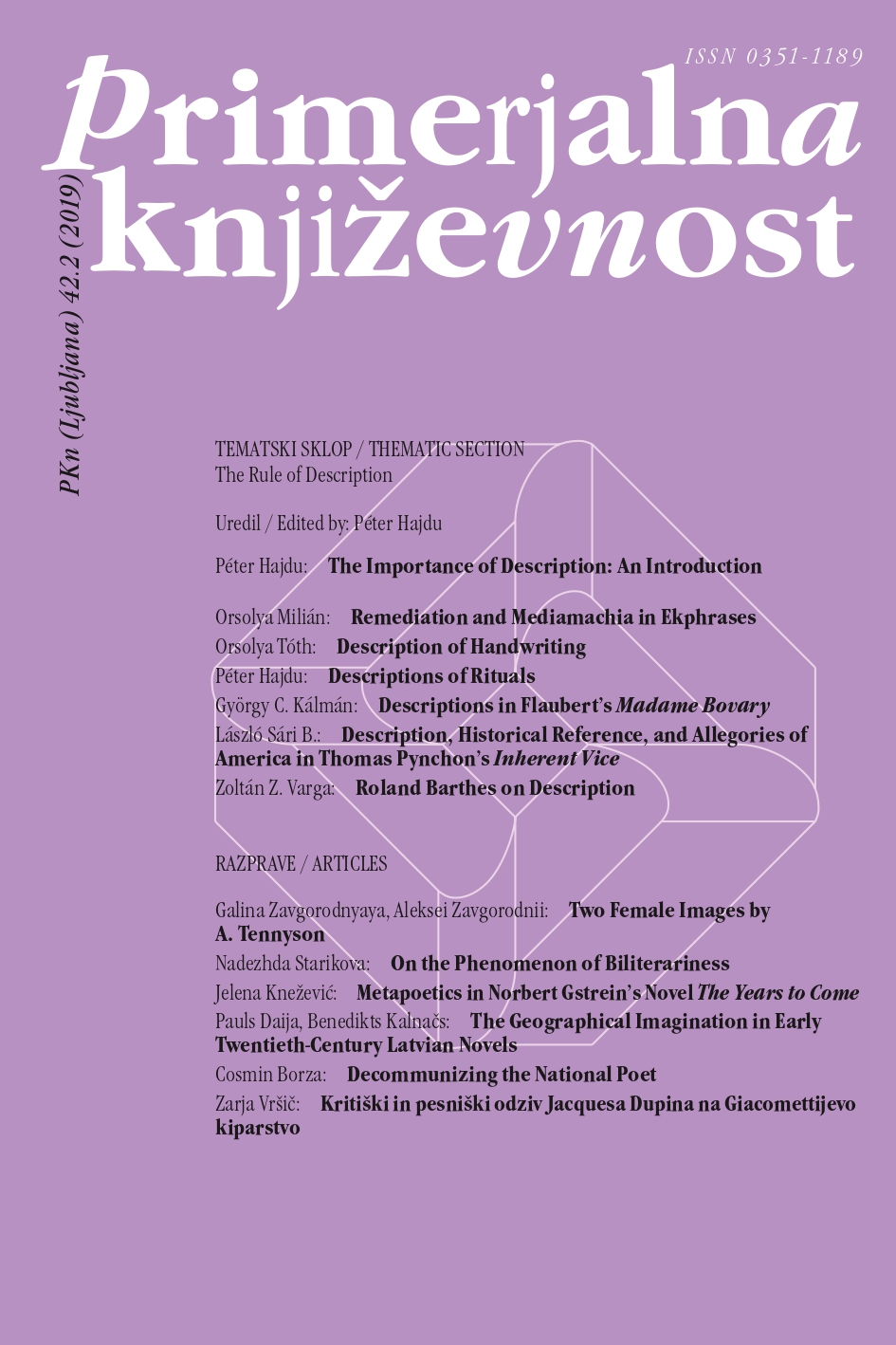The Geographical Imagination in Early Twentieth-Century Latvian Novels
Keywords:
Latvian literature, Latvian novel, twentieth century, literary geography, literary mapping, imagologyAbstract
The article explores the geographical imagination in Latvian novels published during the early twentieth century. We first focus on our experience and preliminary results of the literary mapping, then we turn towards representations of neighboring countries of Latvia as well as selected continents in these novels as case studies. The early twentieth century as a period of extensive migration and growing awareness of global events in Latvian society provides a rich variety of representations of foreign geographical places. By discussing the advantages and limits of literary mapping, we argue that the interpretations of Latvian novels within the perspective of the geographical imagination provide valuable knowledge for the social history of literature. Furthermore, we demonstrate that the research of geographical diversity in novels refers not only to real mobility, but also to stereotypes, therefore the acquired information might be productively used in imagological analyses.References
Akuraters, Jānis. Degoša sala. Riga: Liesma, 1971.
Bray, Patrick M. “Conceptualizing the Novel Map: Nineteenth-Century French Literary Cartography.” Literature and Cartography. Theories, Histories, Genres. Ed. Anders Engberg-Pedersen. Cambridge and London: The MIT Press, 2017. 279–298.
Briedis, Raimonds, and Anita Rožkalne. Latviešu romānu rādītājs, 1873–2013. Riga: LU Literatūras, folkloras un mākslas institūts, 2014.
Daija, Pauls, and Benedikts Kalnačs. “Exploring Space and Place in Literature. Towards Digital Analysis and Literary Mapping within the Context of Latvian Cultural History.” Colloquia 42 (2019): 67–83.
– – –. “Nineteenth-Century Sentimental and Popular Trends and their Transformation in Fin-de-siècle Latvian Literature.” Interlitteraria 23.1 (2018): 162–172.
Döring, Jörg. “How Useful Is Thematic Cartography of Literature?” Primerjalna književnost 36.2 (2013): 139–149.
Firchow, Peter. “America. United States.” Imagology: The Cultural Construction and Literary Representation of National Characters. A Critical Survey. Eds. Manfred Beller and Joep Leerssen. Amsterdam and New York: Rodopi, 2007. 90–94.
Gruzna, Pāvils. “Bursaki.” Domas 1–12 (1914).
Jaunsudrabiņš, Jānis. “Vēja ziedi.” Latvija 239–255 (1907).
Jēkabsons, Kārlis. “Dēmona slāpes.” Dzelme 2–6 (1907).
Juvan, Marko. “From Spatial Turn to GIS-Mapping of Literary Cultures.” European Review 23.1 (2015): 81–96.
Kalnačs, Benedikts, Pauls Daija, Eva Eglāja-Kristsone and Kārlis Vērdiņš. Fin de siècle literārā kultūra Latvijā. Apceres par literatūras sociālo vēsturi. Riga: LU Literatūras, folkloras un mākslas institūts, 2017.
Kalniņš, M. “Dīvaina mīlestība.” Īstais saimnieču, mājturības un ārstniecības kalendārs 1912. gadam. Riga: Freibergs, 1912.
Moretti, Franco. Atlas of the European Novel, 1800–1900. London and New York: Verso, 1998.
– – –. Graphs, Maps, Trees. Abstract Models for a Literary History. London: Verso, 2005.
Piatti, Barbara. “Mapping Fiction. The Theories, Tools and Potentials of Literary Cartography.” Literary Mapping in the Digital Age. Eds. David Cooper, Christopher Donaldson and Patricia Murrieta-Flores. London and New York: Routledge, 2016. 88–101.
– – –. Die Geographie der Literatur. Schauplätze, Handlungsräume, Raumphantasien. Göttingen: Wallstein Verlag, 2009.
Pressner, Todd, and David Shepard. “Mapping the Geospatial Turn.” A New Companion to Digital Humanities. Eds. Susan Schreibman, Ray Siemens and John Unsworth. Chichester: Wiley, 2016. 201–212.
Riesz, János. “Africa.” Imagology: The Cultural Construction and Literary Representation of National Characters. A Critical Survey. Eds. Manfred Beller and Joep Leerssen. Amsterdam and New York: Rodopi, 2007. 79–82.
Rozentāls, Leopolds. Stiprinieku karalis Zigfrīds. Riga: Ansons, 1914.
Skuju Frīdis. Zem Saules. Cēsis: K. Dūnis, 1924.
Upīts, Andrejs. “Plūdi.” Austrums 1–12 (1903).
– – –. Zīda tīklā. Riga: LVI, 1973.
Urbanc, Mimi, and Marko Juvan. “At the Juncture of Literature and Geography. Literature as a Subject of Geographic Inquiry in the Case of Slovene Istria.” Slavistična revija 60.3 (2012): 317–333.


